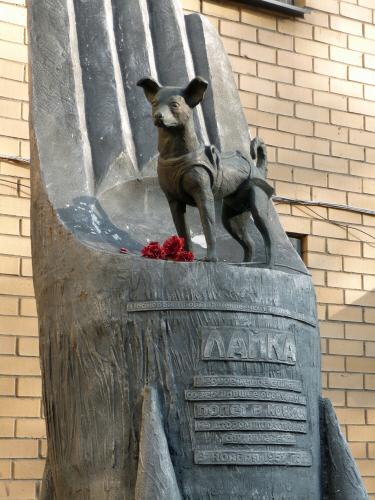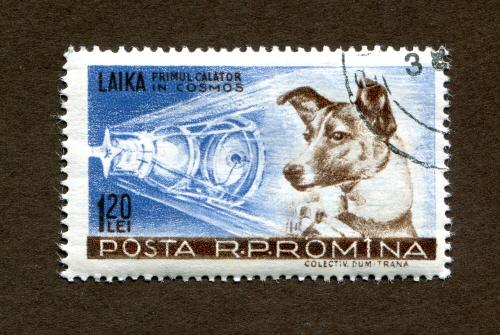Laika went down in history as the first animal to ever go into orbit, but there's so much more to her story... Read on to find out!
Space: The final frontier captures the imaginations of humanity as a whole. Some might be terrified, others fascinated and in awe; but whatever angle you view it from, humanity's obsession with space has made its way into daily life for many of us. From space-themed objects to space-themed food — the moment any progress is reported on anything related to space, our social media channels are flush with tweets and images. Indeed, few things unite us and drive us like our fascination with the unknown of space and desire to explore further.
But in the name of exploration, humans have experimented on animals, and their lives have been the foundation of some incredible space technology and travel as we know it today. We hope by the end of this article, you'll take a moment to think of the precious lives that had no idea they were headed on trips to help us return to earth should we need it, leaving them with worse consequences.
The Most Famous Non-Human Astronaut
No conversation about animals in space would be complete without the inclusion of Laika, the incredible Russian dog who made it to space on Sputnik 2. Laika is perhaps the most famous and well-known animal to have gone to space. Her trip was born of selfish reasons as the flight was intended to see how complex organic forms like humans and animals would survive the conditions of a space launch. Even at the time of her mission, the technology was unfounded, and she was never expected to survive. And so, Laika, one of the goodest girls to ever have lived and died in space, mere hours after the launch due to overheating.
Post the mission and its outcome, it was widely reported that Laika was alive and well for 6 days in space before her oxygen ran out and that she was euthanised prior to oxygen depletion. A huge lie that was made public only in 2002. Since then, Laika has achieved some posthumous recognition in the form of statues.

Humble Beginnings
Laika was born on the streets and lived the life of a stray dog in Moscow, a factor that was crucial in her being chosen for such a mission. Three years old, Laika was picked because she would already be familiar with handling frigid temperatures and hunger. Although she had many names and nicknames (Kudryavka and Limonchik), it was the name "Laika" that became famous.
Before Laika, the Soviet Union and the U. S had only sent animals on suborbital flights. This was a big deal, and so two other dogs were also trained for the mission. Their training was flawed and the ethics of it are highly questionable. The dogs were kept in progressively smaller cages to help them adjust to the tiny Sputnik 2 cabin. They were placed in centrifuges and were made to undergo all manners of space flight simulations to adjust them to the process. They were also trained to eat a high-nutrition gel in lieu of food.
A more cynical person might even say these dogs were chosen because they were simply picked off the streets and considered highly replaceable.
The Ethics of It All
One could argue that our training of them and using animals in such situations have helped us reach the technological heights we stand at today. But, is success on the back of someone else's pain and real success? Laika never had a say in any of this. She was simply a three year old dog. Imagine her confusion at being given nicknames and then being put through awful training procedures she had no way of understanding.
It was likely the most complicated to the poor dog when she was given small moments of respite and love. According to the records, one of the missions’ scientists took Laika home to play with his children. His reasoning was that he wanted to do something nice for her because she had so little time to live. In the same vein, just before takeoff, technicians planted kisses and spoke kind words of goodbye knowing and feeling some pain with her being a sacrifice to science.
At the time of the whole incident, the ethical issues regarding the mission Laika had been sent on went unaddressed for a fair amount of time. The key issue being with the fact that Laika had been knowingly and purposely sent on a suicide mission. The mission itself was a cornerstone in the ethical debate we are all familiar with today - that of the mistreatment of animals and lab testing on them in the name of advancement.
The world eventually, even if a little too late, did show up for Laika, and with time and the fight of many activists, animal rights, and welfare groups our treatment of animals even in science is changing (could go faster, but change is change after all). There is little solace in the fact that Laika taught the world, and even the scientists who were responsible, a lesson in empathy.

Some scientists expressed regret with sending Laika to space. According to one scientist who compared dogs to babies who cannot speak, the mission did not justify the death of a dog. But hope springs eternal, and Laika's story did mark a change. Future space missions carrying animals would be designed to be recovered, something that definitely changed the way animals were treated in such capacities. Their lives would mean more to the people manipulating them; their lives would carry value.